Tool Bench Hardware Bike Tire Repair Kit
The enquiry
- Why yous should trust us
- Who this is for
- Essentials: Rema TT 02 Touring Repair Kit
- Essentials: Pedro's Tire Levers
- Essentials: Lezyne Pressure Drive
- Overnice-to-haves
- How we picked and tested
- The competition
- Sources
Why you should trust us
To get started, nosotros consulted a broad assortment people for this guide, with a wide diversity of cycling styles. They've all put together kits that are unique to their personalities and needs. It's a deep, satisfactory joy to lay out a finely curated kit, and we're hoping you'll discover a carry method that speaks to you.
When I interviewed Ramona Marks, she was a mechanic at Bicycle Kitchen in LA. She has logged thousands of miles touring the world on her bicycle since 2010. Her kit is outfitted with gear that makes life easier for a touring cyclist, such as some full-size tools, which make frequent field repairs more manageable.
I spoke to Scott Karoly, a sales associate at Alameda Bicycle, who carries the essentials for his urban commuting, plus some special wrenches for his specific bike.
And I spoke with Alison Tetrick, a pro athlete and member of the board of directors for U.s. Cycling. She carries a downsized road-riding kit and relies on COii cartridges for fast inflation, because she gets two or three flats a 24-hour interval, every day.
I besides spoke with resident mechanic Cari Z at (the sadly at present airtight) Bay Area Bikes in Oakland, California, a former messenger who had a dozen sneaky tricks for changing tires, conveying tools, and preventing flats (but, alas, no photos of her bike bag).
Who this is for
We focused on tools that would be useful to a commuter—someone trying to apply a wheel as a functional way to get around town, equally opposed to riding recreationally (route biking and mountain biking). That said, it'southward a wild and wooly bicycling world out at that place, and the streets are packed with and then many different bikes, all shapes and sizes, new and old. Customizing your flat-fixing kit has advantages over buying a preassembled kit that always contains a tool (or 2 or three) that'south a piece of junk, or you don't need. Or it's missing something you do need. If you build your own kit, at least you lot know everything works. And you can add only what'due south necessary for your specific cycle without ending up with stuff you don't demand.
Route riders demand lightweight, tiny tools that can fit into jersey pockets. A lot of those items are made of carbon fiber, which is lighter than aluminum. Other iconic trappings of road riding, like COii cartridges and spandex outfits, are as well geared toward minimalism, merely all of that downsizing comes at a price. Commuters don't take to be every bit concerned with weight, so unless yous covet something specific, don't spend the extra coin.
Mount bikers are in a different world of repair entirely, one that borders on the comedic absurd. It includes large pumps designed to make full upward big, fat tires that squish over things, and a medley of assorted slimes meant to be injected into tubes or tires. In that globe, the number of days it takes you to fix your tire and return from the wilderness is a badge of courage—bonus points if you're bleeding—and nosotros're guessing that'due south not what you're going for next time you lot set out for groceries.
Commuters need products that are effective and reliable. The 24-hour interval yous need them, they accept to work. The essentials listed in this guide are the items you must take if you lot ever hope to get going over again afterward having a apartment. If you do goose egg else, option up these three things and take a 2d to acquire how to utilize them.
Essentials: Rema TT 02 Touring Repair Kit

Our pick

A skillful patch will stick to your tube plenty to keep air from leaking out. A swell patch volition act like a second peel and actually strengthen the tube where it's applied, flexing and stretching with the tire. Later on 36 hours of testing, our official endorsement goes to the Rema TT 02 Touring Repair Kit. Its patches do everything other patches do, just better. The edge of the patch is too ruffled, which provides more than border surface surface area to bond—that's a expert affair.
Patch kits come with patches in a few different sizes, a small-scale bit of sandpaper, and a tube of vulcanizer. Vulcanizer is the "glue." Cari Z, who was a mechanic at Bay Expanse Bikes at the time of our interview, explained, "Vulcanization is the chemic bonding process that takes identify between patches" and the tube.

There are patches that don't crave vulcanizer—the infamous peel-and-stick. Ane make, the Park Tool GP-ii, has some genuinely enthusiastic endorsements, and so we tested information technology. I applied Park Tool patches to four different tires, at three dissimilar psi levels (lx, 90, and 120). 3 of the four didn't hold—two released within minutes. The fourth deflated overnight. I redid the test, but repeated a 2d time, they all leaked inside a solar day.
Though I often have colleagues and acquaintances text me smug anecdotes of their skin-and-sticks working, I am not convinced they're actually working. They could possibly be pressed firmly up against the tire rim, or some other incalculable magic, but if it were me I'd toss those in the garbage and go serious. This is wheel repair, people.
In addition to the Rema patches, put a new tire tube in your kit. The all-time method for dealing with a flat roadside is to swap out the tube and save the task of patching for later. If you're non sure what size your tires are, it'south printed on the sidewall of the tire. This inner-tube buying guide has some photos of where to look. What brand is virtually irrelevant as many tubes become manufactured in the same identify, so whatever your local shop has behind the counter for nether $x will work fine. The only reason to spend more would be to save weight.
At present you might be wondering: "I'chiliad carrying a tube; why carry patches at all?" As insurance for the unforeseeable. Wirecutter senior editor Christine Ryan admits she didn't utilise to pack them, simply said, "I've regretted that conclusion when I've had a flat on a ride, used my spare tube, and then, half an 60 minutes subsequently, had a 2nd flat. Also, lots of people aren't very expert at figuring out—or don't accept the time to figure out—what caused their flat and remove the cause: thorn, eensy fleck of glass, any. And so they promptly accept a second apartment, and anybody else laughs at them."
And then don't go laughed at by your cycling brethren—be the hero instead. Ever bank check your tire for what caused the apartment, become rid of it, and drag effectually a patch kit just in case.
Essentials: Pedro's Tire Levers

Our choice
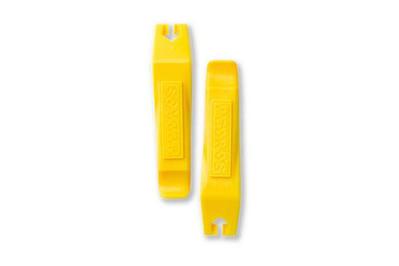
Every expert I spoke to recommended Pedro's Tire Levers by name. They have a wide body—a different shape than other models we tested—and that prevents breakage, but more of import, the broad, flat area of the tip helps it stay locked under your tire. When a lever slips from under the dewdrop of the tire, you lot can end up repeatedly scraping your knuckles on the spokes of the wheel, which is so annoying. Pedro's levers are pocket-size enough to fit into a saddlebag, are sold widely in bike shops, and fifty-fifty come with a lifetime guarantee. If ane breaks, Pedro's will replace it.

More than whatsoever other tool in the kit, a reliable lever makes irresolute a tire easier, particularly if yous have route wheel tires, which are hard to remove. Still, throughout testing, levers seemed to be the 1 item more than prone to failure and poor blueprint than annihilation else. For case, I found a random orange lever floating effectually my basement and I threw it in the test puddle for fun—it seemed solid enough ... until I began prying at the rim of a tire. It aptitude direct in one-half, slowly and smoothly, similar taffy, and so was boomerang shaped forevermore.
The Pedro's lever slipped only once throughout testing, though that may have been my fault because I was spaced out later on changing xvi different tires. So they're not foolproof, only they are far and abroad more reliable than the next closest competitor, from Park Tool, because the small, rounded tip on that one is difficult to keep seated nether the tire. Not impossible, only I wouldn't choose it over Pedro'southward.
Aaron Gulley, writing for Exterior, states, "I can't count the number of times I've snapped cheap plastic sticks, shredded my hand in the process, stomped around cursing in pain for ten minutes, and so, insult to injury, been tool-less and unable to get my tire off anyway. That will never happen with Pedro's."
Essentials: Lezyne Pressure level Drive

Our pick
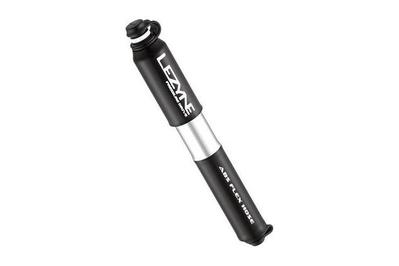
Cycle manus pumps aren't substitutes for floor pumps. They will never piece of work as well—pumping a tire without using the ground for leverage is bad-mannered at best and demoralizing at worst. Then consider this an on-the-road model only, and if you're looking for a floor pump, check out our full guide.
The Lezyne Force per unit area Drive's solid aluminum body, smooth pumping action, removable hose, and secure pump-to-valve attachment make for a handheld pump that is functional and efficient. Among all the pumps nosotros tested, aught reached this level of quality at the same price.
The standout feature is the detachable hose that accommodates both Presta and Schrader valves. To use the pump, remove the hose from its storage place within the pump'southward body. Each end of the hose is clearly marked with either "Presta" or "Schrader." Screw one end onto the pump's body. Then, instead of relying on friction or a thumb lock—the other two common methods of attaching a handheld pump to a valve—you spiral the other stop onto the threaded tip of your valve. Every time, the seal held fast no matter how hard we pumped. And like all hose attachments, this ane reduces the odds of angle or even breaking the valve.
The Pressure Drive is advertised as a low-volume, loftier-pressure pump for road bikes, and we were able to go to 100 psi on our 700c tire in 300 strokes. Fifty-fifty though that's a serious, sweaty workout, it's a high bar to gear up for a handheld pump, one that not all of the pumps nosotros tested could attain. Knowing that high-pressure road tires are this pump'due south specialty, nosotros were surprised we could fill a lower-pressure tire without taking a long, long time. Information technology took us 150 strokes to fill a hybrid tire to 35 psi, and 290 strokes to become a mountain bike tire to 30 psi. That may sound like a lot, but those are very respectable numbers, especially given the pump's small size.
With pumps like this, which attach to a valve stem by screwing information technology on, information technology'southward possible to unscrew a removable valve core while removing your pump. (At that place goes all your hard-earned air, in a blitz!) If you like to use valves with removable cores—you know who y'all are—the Pressure Drive has an integrated valve core tool. This is besides what you need to fix a leaky stalk, which could be the cause of your flat in the first identify.
If you lot ride a mountain bike or any kind of tire that has a very low psi rating, a high-book, low-pressure pump may be a better choice to take on the trail with yous. The Lezyne Alloy Bulldoze is the equivalent of the Pressure Bulldoze for mountain bike tires.
Lezyne besides provides a two-year warranty that covers manufacturer defects, and you lot can supersede worn-out O-rings and the like with replacement parts from the Lezyne site.
Overnice-to-haves
Our pick
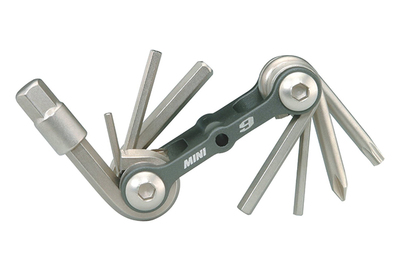
Writer Peter Flax, the former editor-in-chief of Bicycling mag, rode over ane,000 miles and tested 15 tools for our now-archived full-length guide to multi-tools, and he ended the Topeak Mini 9 is the best for casual cyclists. Information technology's tiny, it'southward calorie-free, it's easier to go some leverage with than other tools that have different designs. It'southward not meant for serious wrenching on your bike, but information technology'due south good for on-the-fly adjustments.
Information technology includes nine tools: seven hex bolts, one torx commodities (the star-shaped one), and a Phillips screwdriver (too the star-shaped 1). Like Peter says in our guide, if you lot accept a newer mount cycle or route cycle it pays to take a quick await at what types of tools you lot demand, as torx bolts are becoming more common. And a quick glance at the bottom of your shoes or derailleur bolts will confirm if a Phillips caput is the right pick.
Otherwise, this tool should serve the average commuter well. Specifically, nosotros think you lot'll find the size 4, 5, and half-dozen hex keys, extremely common sizes in bicycles, very helpful. They'll suit seat-post heights or let you remove the saddle entirely, or tighten a loose stem that's always rattling apart. The Phillips head will tighten loose bolts on shoe cleats or the rear derailleur. The most common use for the torx would be adjusting disc brakes if you accept 'em.

Our choice
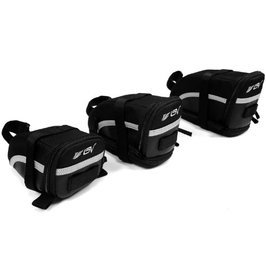
The BV Bicycle Strap-On Saddle Bag is the best option for your money. Sure, it'southward some random brand, but later on we compared eight popular models, nosotros noticed it'southward identical to the better-known versions, has less Velcro (which is a large advantage), and costs half as much.
On the left higher up is our acme choice, the BV, and on the correct the Serfas Speed Purse, some other option much loved by Amazon users. They're both made from the same design and same materials, down to the mesh and central fob in the interior. The BV nevertheless, is one-half the price.
Ane key difference, that you can come across in the photo, is that the BV uses buckles instead of Velcro on the straps that attach the bag to the underside of the saddle, something much more than of import than it may seem. A pair of wheel shorts (or any shorts) volition shred rapidly if they're rubbing against that tiny bit of Velcro protruding from the side of the bag, and it's sure to destroy expensive sweaters and gym dress if you stuff the bag into your haversack or messenger purse.
The fabric attachment system is low-tech, but that seems to exist helpful, as it can adjust to seat rails of different widths. One fancier option you might see on more expensive seat numberless is a quick-release mount that you install under your saddle. But those accept a fixed width, and therefore can fit under seats with only those exact specs. Brooks saddles, for instance, are too wide for these mounts.
Yet, these things are fairly standardized and if you have a newer bicycle it's likely you'll take no issue getting a quick release under there if yous want—merely check your bike first. And as such, nosotros've establish the adaptability of the strap mount to be a great advantage.
Which size is right for you? It depends. Seat bags aren't supposed to carry windbreakers or bike locks or animals. They are meant for emergency tools.

This is how your patch supplies fit into the size medium BV seat handbag, or 100ish cubic inches. Tube sizes vary widely—this 1 is smallish, for a 700c road tire. A 26-inch tire, like you lot would see on a hybrid bicycle, is much bigger.
In spite of seat bags' diminutive size, a lot of people actually, really want them to accommodate more stuff. If that's you, the medium and big seat handbag (just not the small) have an extendable gill at the bottom, which you can see in the prototype up peak. It zips open to create more room. With information technology unzipped, we could cram a wallet, keys, and phone inside the medium likewise.
One flaw? Seat bags can block taillights. This one has a loop on the exterior yous can clip your blinker to. Seat numberless besides typically practise not fit hand pumps. No big bargain, but toss the pump into your bag, stick it in a jersey pocket, or mount it to your cycle (the Sport Drive comes with a mountain).

Our pick
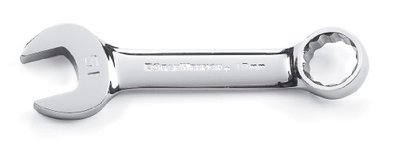
Many bikes, including older models and track bikes, have bolts attaching the wheels to the frame instead of quick-release levers. If your wheels are bolted on, in almost cases you'll need a 15 mm wrench to remove information technology. Nosotros didn't exam wrenches, because there aren't that many tiny xv mm wrenches, merely the GearWrench 15mm 12-Point Stubby Combination Wrench is perfect for stuffing into a apartment kit and Amazon reviewers seem to think the aforementioned. Our experts also recommended the Surly Jethro Tule, simply it's expensive and harder to observe.
How we picked and tested
First, I researched. I looked at Amazon's top-rated products and their user reviews. And then I consulted Bicycling magazine, Gear Junkie, Bike Radar, Exterior, and the occasional fleck past Lennard Zinn via Velonews. I likewise found some worthwhile discussions at Cycle Forums. Then I spoke with iv experts, Ramona Marks, Scott Karoly, Cari Z, and Alison Tetrick, riders from all beyond the spectrum, who tour, repair, and race.
Based on what we plant, nosotros chose the nigh relevant items and used them all. To test patches, I repaired holes using four different types of patches, from Novara (REI's now-discontinued house brand), Park Tool, and Rema. Patching a tube isn't hard but there are a few tricks, and the key was attending to detail and patience. I was extremely diligent in following proper patch procedure, which includes a thorough sanding of the entire area to be patched (for max stickiness) and properly letting the vulcanizer dry out on both surfaces before applying. For the peel-and-stick patches, I went so far every bit to prep the area with canned air to ensure every bit tight a seal as we could perchance muster.
I tested four popular levers, including the Crankbrothers Speedier Lever, a Quik Stik, Pedro's, and the ubiquitous blue Park Tool. We inverse 4 dissimilar types of tires (mountain, hybrid, road, and track) with 4 different psi levels (twoscore, 60, ninety, 110) and watched how each performed.
I chose to exam these four levers afterwards eliminating everything out in that location that'due south not advisable for a roadside emergency kit. That includes metallic levers. They're durable, simply co-ordinate to touring cyclist Ramona Marks, "Metallic tire levers are trouble. Information technology'south possible to rip your tube even with the plastic ones if y'all're non careful, and then metal is out of the question, and you don't want to put pressure confronting the wheel rim with a metallic lever."
If you exercise, you're asking for a bent rim, which means buying a new wheel. We also eliminated metal-core levers, which are metal levers with a plastic outside coating. I eliminated everything that looked cheap, bendable, or brittle. I also eliminated long, large single levers that would be more comfy sitting on your calm tool bench.
We bumped a lot of product out of the test pool for hand pumps, too. You don't need a lot of specialized blueprint when it comes to a hand pump, and so we gear up aside carbon models and mitt pumps with two-stage designs. We also didn't consider CO2 cartridges for this guide, though I'g 100 percentage aware that there are commuters who employ and love them.
First, carbon. You lot already know you don't need it for your coincidental weekend pursuits, because y'all're not counting ounces the way a professional route racer would. But to quote an article from Velonews, "Recall that professional athletes operate in an entirely different environs than the rest of us. They are all very close to each other in terms of fitness, and they are as well all very close to being the accented best a human being existence can be. In curt, yous're much better off upgrading your legs and dropping body fat through proper training and diet."
As a tester and editor subjected to a relentless onslaught of press releases highlighting the benefits of new, lightweight, (and expensive) gear, this contrary sentiment delights me. It'southward honest, and accurate.
Next, two-stage designs. At that place are two types of mitt pump. HV (high-volume) pumps, ones that pump a lot of air but don't have a lot of pressure, which are used for mountain bikes. The Lezyne Blend Drive is a high-volume pump. And then there are HP (loftier-force per unit area) pumps, which pump a small amount of air merely can inflate to very high pressures and are used on road bikes. Our top selection is a high-pressure level pump.
A 2-phase hand pump tries to ally the best features of both types of pumps: the quick inflation of high volume that can achieve the higher psi ranges of loftier force per unit area. But to steal a quote from our flooring pump guide, "You pump eight times or yous pump ten times—what does information technology affair?" That's a quote from Daimeon Shanks, who at the time was a mechanic for the Garmin-Sharp pro tour team—that'due south right, Tour de France, baby.
Basically, you're stuck with toggling between systems for the advantage of a few pumps, and it doesn't seem worth information technology. In the original iteration of this guide, I tested 12 pumps and inflated three different tires completely full to their psi rating, and measured how many pumps it took. Yasuda did similarly for his revamped full-length exploration. That'southward 36 tires, and I can guarantee there is no deviation between 50 pumps and 100—it'southward all terrible.
Finally, comparing seat numberless was fun. The identical construction of every model revealed itself immediately. That ever feels like a win. Then nosotros used them: fastened them all to the wheel, inspected them for nefarious Velcro, and vetted basic usability to determine the best choice.
The competition
Patches
Levers
We like, and recommend, the Crankbrothers Speedier Lever. If you accept to selection only one, go with the Pedro'southward, but if yous desire a backup or take some hard tires to unseat, Crankbrothers is a great option. It's merely one lever (every bit opposed to a set of two, like the Pedro's) and it's longer, so we didn't pick it over the Pedro'south for portability reasons. Only information technology's an excellent tool. It has a wide handle y'all can grip with your whole hand. Like the Pedro's, the tip is the right size and shape to prevent slipping and stay in identify, and the shape of the handle happens to protect your knuckles if you do slip. Even in situations where I didn't demand it, I liked having information technology because information technology fabricated me feel like a pro.
Park Tool's TL-ane Levers were Pedro's stiffest contest because they're so pervasive, simply not from a literal stiffness standpoint. Cycle shop employees had plenty of tales of broken Park Tools—they had none about the Pedro's. In our testing the Park Tool levers slipped, likewise.
People who use Quik Stiks love them. Ours removed nigh tires with the ease that proponents swear by. Only they struggled with the route tires. The tips aren't as broad or chisel-like as the Crankbrothers Speedier Lever's and are harder to work in tight situations.
Seat numberless
The Serfas Speed Purse has the same pattern every bit the BV, but is about twice as expensive. It also attaches with Velcro, which isn't ideal.
Topeak's Aero Wedge Pack is a slightly dissimilar shape and size than the other bags we tested, and it worked fine, but information technology'southward more expensive and didn't take annihilation better to offer than our option.
The mountain for the Topeak Aero Wedge with QuickClick did fit my seat, and the device worked as advertised. Merely for compatibility reasons, we like the basic models for most people.
I used the Lezyne Micro Caddy to encounter if a size below small would be an selection for commuters, but it's non big enough to concord larger tubes, the sleeves inside of it for levers tin can't fit the broad Pedro'south, and it couldn't fit my multi-tool (I have a pretty large i). Pocket-size is good, just this is too small, unless you lot're a road bike rider.
I love the design of the Lezyne Road Caddy, which opens like a clamshell to reveal your repair kit and then folds away into the perfect shape to store in a handbag or haversack. But again, this is designed specifically for route bikes and can't fit a larger tube, restricting its practicality.
Spurcycle, the company that makes our favorite bicycle bell, makes a saddlebag, too. And at beginning glance, it looked elementary and fifty-fifty stylish: a black cloth sack, shaped like a lunch bag, that you fill, fold over, and wrap tight with a Velcro strap that also loops through your saddle's rails. We have our worries well-nigh Velcro, but after a few weeks of testing, nosotros saw no sign of abrasion on our cycle shorts. However, on longer rides (four or v hours), the bag tended to slide out of its Velcro confines. After the first instance—and thinking the problem was user error—nosotros double-checked the instructions on the Spurcycle site and reinstalled the bag, but it kept unraveling.
Sources
-
Cari Z, then mechanic at Bay Area Bikes and former messenger , interview
-
Ramona Marks, bike tourer and quondam mechanic , interview
-
Alison Tetrick, pro cyclist , interview
-
Stephen Regenold, Hose-Equipped Mini Bike Pump Put to Examination, Gear Junkie , July 5, 2013
-
Lennard Zinn, Technical FAQ with Lennard Zinn: Blowing up tires, taking them off, and more, Velonews , October 19, 2010
-
Lennard Zinn, Technical Q&A with Lennard Zinn – Large molecules and short frames, Velonews , February iii, 2009
-
Aaron Gulley, viii Biking Essentials under $6, Outside , September half dozen, 2013
-
Jim Gourley, Wheel weight and the myth of 'fast' bikes, Velo News , August vi, 2014
-
Scott Karoly, Alameda Bicycle, in-person interview , June 1, 2014
Comments
Post a Comment